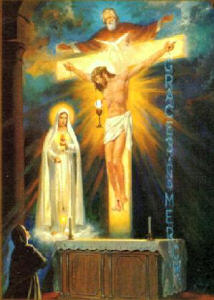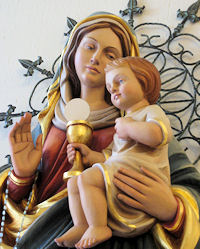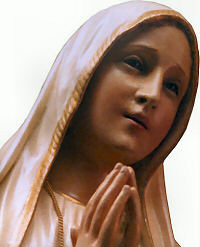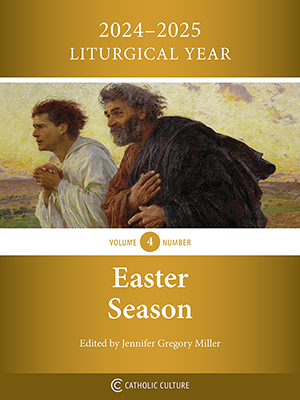Easter: May 13th
Tuesday of the Fourth Week of Easter; Opt. Mem. of Our Lady of Fatima
Other Commemorations: Our Lady of the Most Blessed Sacrament (Hist); Julian of Norwich, Religious (Hist)
» Enjoy our Liturgical Seasons series of e-books!
Today the Church celebrates an Optional Memorial of Our Lady of Fatima, which is a title of the Blessed Virgin Mary following apparitions to three shepherd children — Lucia, Jacinta and Francisco — in Portugal in 1917. The message of Fatima includes a call to conversion of heart, repentance from sin and a dedication to the Blessed Virgin Mary, especially through praying the Rosary. This optional memorial is new to the USA liturgical calendar and is inscribed on May 13.
Today is also the traditional commemoration of Our Lady of the Most Blessed Sacrament. This title was given to our Blessed Mother in May 1868 by Saint Peter Julian Eymard to honor her relationship to the Holy Eucharist and to place her before us as a model in our duties and devotion to the Blessed Sacrament.
Julian of Norwich, England (1342-1423) is traditionally honored today. She is not included in the Roman Martyrology but popular piety sees her as a holy woman of God, and so often refer to her as Mother, Saint or Blessed Julian. She is most known for her book, Revelations of Divine Love.
Meditation: Tuesday of the Fourth Week of Easter
The Divine Goodness
1. "The earth is full of the goodness of the Lord." The sacred liturgy cries out today in admiration at the goodness of God. The very purpose and end of the creation of the universe was to communicate the divine goodness to creatures. No mere creature, of course, is capable of receiving the full measure of the divine goodness, and no mere finite being is capable of reflecting all the beauty of God, yet "the earth is full of the goodness of God." But perhaps the goodness of God is more perfectly reflected by the diffusion of the infinite perfection of the Creator among many creatures. This would no doubt account for the staggering variety so evident in the universe. By the prodigal communication of His goodness to His creatures, the divine Artist gives them a faint notion of His infinite perfection and beauty.
2. "The earth is full of the goodness of the Lord, alleluia: by the word of the Lord were the heavens made, alleluia, alleluia." The story of the creation of the world is a beautiful story. Why the universe was created we know; when it was created we can only conjecture. Faith assures us that the world did not exist from all eternity; the world is not coeternal with God; it is His creature and came into being in time. Many modern scientific discoveries are taken by their discoverers as proofs from reason of the beginning of the world at some definite time. While it may be that the age of the universe is indicated by geological strata and similar evidence, this evidence is only an indication and not a valid proof from reason. Neither the eternity of the world nor its beginning in time, St. Thomas tells us, can be proved from reason. Since God's creative action was free, and since He existed from all eternity, He could have created from all eternity, or He could have created in time. Whether the world was created from all eternity or was created in time, does not change the fact that it was created, and that it was created to reflect the goodness and beauty of God. The sacred liturgy is not much concerned with the question of when the world was created; it leaves that to the scientist and the philosopher to discuss. It is fully occupied with the thought of the goodness of God in filling the world with His divine perfection. "The earth is full of the goodness of the Lord."
3. "I am the good shepherd." Perhaps no more striking figure could have been chosen to express the goodness of God as manifested in the incarnation of the Son of God, than that of the good shepherd. Our Lord was accustomed to choose figures of speech and illustrations which could be easily grasped by the people to whom He preached. The picture of the shepherd caring for his sheep on the hills of Palestine was a familiar one to the people of that day. There is something very charming about the idea of a man caring tenderly for a group of foolish, errant, improvident animals such as sheep. The shepherd by his very nature is far superior to the animals he cares for. It is an act of great condescension for him to devote his time and his labor to the welfare of his sheep. But what our Lord was trying to tell us was that God is like that. He stands infinitely above His creatures, and yet there is no limit to the solicitude He has for them.
The extent of the solicitude of the Good Shepherd, Christ, for His human sheep, is outlined for us by St. Paul in the Epistle: "Who His own self bore our sins in His body upon the tree: that we being dead to sins, should live to justice: by whose stripes you were healed. For you were as sheep going astray: but you are now converted to the shepherd and bishop of your souls." But solicitude on the part of the Shepherd is not enough. The sheep must respond to this solicitude with faith and confidence in His concern for their salvation. Even God cannot save us unless we cooperate with Him. This is true also of the bishops and priests appointed by Christ to carry on His work in this world. The bishops and priests too, are solicitous for the salvation of their flocks. But they must have the cooperation of the people or their efforts will be in vain.
—Benedict Baur, OSB, The Light of the World, Vol. 2
Our Lady of Fatima
 The famous apparitions of the Virgin Mary to the children of Fatima took place during the First World War, in the summer of 1917. The inhabitants of this tiny village in the diocese of Leiria (Portugal) were mostly poor people, many of them small farmers who went out by day to tend their fields and animals. Children traditionally were assigned the task of herding the sheep.
The famous apparitions of the Virgin Mary to the children of Fatima took place during the First World War, in the summer of 1917. The inhabitants of this tiny village in the diocese of Leiria (Portugal) were mostly poor people, many of them small farmers who went out by day to tend their fields and animals. Children traditionally were assigned the task of herding the sheep.
The three children who received the apparitions had been brought up in an atmosphere of genuine piety: Lucia dos Santos (ten years old) and her two younger cousins, Francisco and Jacinta. Together they tended the sheep and, with Lucy in charge, would often pray the Rosary kneeling in the open. In the summer of 1916 an Angel appeared to them several times and taught them a prayer to the Blessed Trinity.
On Sunday, May 13, 1917, toward noon, a flash of lightning drew the attention of the children, and they saw a brilliant figure appearing over the trees of the Cova da Iria. The "Lady" asked them to pray for the conversion of sinners and an end to the war, and to come back every month, on the 13th.
Further apparitions took place on June 13 and July 13. On August 13 the children were prevented by local authorities from going to the Cova da Iria, but they saw the apparition on the 19th. On September 13 the Lady requested recitation of the Rosary for an end to the war. Finally, on October 13, the "Lady" identified herself as "Our Lady of the Rosary" and again called for prayer and penitence.
On that day a celestial phenomenon also took place: the sun seemed to tumble from the sky and crash toward earth. The children had been forewarned of it as early as May 13, the first apparition. The large crowd (estimated at 30,000 by reporters) that had gathered around the children saw the phenomenon and came away astounded.
Official recognition of the "visions" which the children had at the Cova da Iria came on October 13, 1930, when the bishop of Leiria - after long inquiry - authorized the cult of Our Lady of the Rosary at the site. The two younger children had died: Francisco (who saw the apparition but did not hear the words) on April 4, 1919, and his sister Jacinta on February 20, 1920. Sister Lucia died on February 13, 2005, at her Carmelite convent in Coimbra, Portugal, after a long illness.
—Excerpted from Dictionary of Mary, Catholic Book Publishing Company
The Message of Fatima
 The public message of Fatima recalls that of Lourdes. Through the children Mary urges prayer for sinners, recitation of the Rosary, and works of penance. On October 13 she said: "I have come to exhort the faithful to change their lives, to avoid grieving Our Lord by sin; to pray the Rosary. I desire in this place a chapel in my honor. If people mend their ways, the war will soon be over."
The public message of Fatima recalls that of Lourdes. Through the children Mary urges prayer for sinners, recitation of the Rosary, and works of penance. On October 13 she said: "I have come to exhort the faithful to change their lives, to avoid grieving Our Lord by sin; to pray the Rosary. I desire in this place a chapel in my honor. If people mend their ways, the war will soon be over."
But Mary also confided several "secrets" to the children, some of which Lucy subsequently transmitted. Presumably there was prediction of another war in the near future and a request for special veneration of the Immaculate Heart of Mary. The final secret Lucia is thought to have entrusted to Pope John XXIII.
As at Lourdes, the "apparitions" of Fatima have brought crowds of visitors. Pilgrimages, which began in the summer of 1917, have experienced growing success, not only among the Portuguese themselves but also among people from other countries, including the United States. The national pilgrimage following ecclesiastical recognition of the apparitions (May 13, 1931) is said to have drawn more than a million participants.
Popes have shown exceptional favor toward Fatima, Pius XII, Paul VI, and John Paul II in particular making a visit to the shrine. The papal interest and the basilica built at the site of the apparitions has helped to swell the summer pilgrimages to Fatima. Crowds comparable to, and sometimes larger than, those at Lourdes are not uncommon. In a rustic setting, pilgrims hear the message repeated that Mary spoke to the children: prayer, works of penance, recourse to her Immaculate Heart.
—Excerpted from Dictionary of Mary, Catholic Book Publishing Company
Patronage: diocese of Leiria–Fátima, Portugal
Highlights and Things to Do:
- Visit Catholic Culture's special section on Our Lady of Fatima.
- For further reading:
- See Catholic Cuisine for food ideas.
- Virtually visit the Shrine of Our Lady of Fatima in Portugal.
Our Lady of the Blessed Sacrament
 This title penetrates the mystery itself of the Eucharist, and when well understood, manifests to us the most important part granted to Mary in the economy of the Holy Eucharist.
This title penetrates the mystery itself of the Eucharist, and when well understood, manifests to us the most important part granted to Mary in the economy of the Holy Eucharist.
If we have thoroughly seized Pierre Eymard's thought we understand that she is, first, the Mother of Jesus, giving to the Word her most pure blood, which was changed on the day of the Incarnation into His own Body, into His own Blood, in order to consecrate it later, on the night of the Last Supper, into His Sacrament of Love.
Our Lady of the Blessed Sacrament is Mary receiving in quality of universal dispensatrix of grace, the full and absolute disposition of the Eucharist and the graces that It contains, because this Sacrament is the most efficacious means of salvation, the fruit par excellence of the Redemption of Jesus Christ. To her, consequently, it belongs to make Jesus in the Sacrament known and loved; to her it belongs to spread the Eucharist throughout the world, to multiply churches, to raise them in infidel lands, and to defend faith in the Eucharist against heretics and the impious; to her it belongs to prepare souls for Communion, to rouse them to make frequent visits to Jesus, and to assist zealously at the Holy Sacrifice of the Mass. She is the treasure-house of all the graces comprised in the Eucharist, both those that prepare the soul for It and those that flow from It.
—Month of Our Lady of the Blessed Sacrament by St. Peter Julian Eymard
Highlights and Things to Do:
- Read the Month of Our Lady of the Blessed Sacrament by Pierre Julian Eymard.
- Pray the novena to Our Lady of the Blessed Sacrament.
Julian of Norwich
 Almost nothing is known of her early life before she became an anchoress. It is unknown if she was from Norwich or chose to move there, and even not verified that her name was Julian before she became an anchoress near the church of Saint Julian. Recluse under the direction of Benedictines in Norwich, England. Mystic, visionary, and writer. Her book, Revelations of Divine Love, which contains sixteen revelations she received while in an ecstatic trance, is still in print. She meditated on, spoke on, and wrote on the power of love of evil, Christ’s Passion, and the nature of the Trinity. In her early 60s she shut herself in complete seclusion at Conisford, Norwich, and never left again.
Almost nothing is known of her early life before she became an anchoress. It is unknown if she was from Norwich or chose to move there, and even not verified that her name was Julian before she became an anchoress near the church of Saint Julian. Recluse under the direction of Benedictines in Norwich, England. Mystic, visionary, and writer. Her book, Revelations of Divine Love, which contains sixteen revelations she received while in an ecstatic trance, is still in print. She meditated on, spoke on, and wrote on the power of love of evil, Christ’s Passion, and the nature of the Trinity. In her early 60s she shut herself in complete seclusion at Conisford, Norwich, and never left again.
Not much is known about her personal life, even if her name was truly Julian. She was born around 1342 and died in 1423, lived as an anchoress near the Church of St. Julian in Norwich, England. Because she was never formally beatified or canonized, she is not included in the Roman Martyrology but popular piety sees her as a holy woman of God, and so often refer to her as Mother, Saint or Blessed Julian.
Highlights and Things to Do:
- Read more about St. Julian:
- See this online source for her writings.






